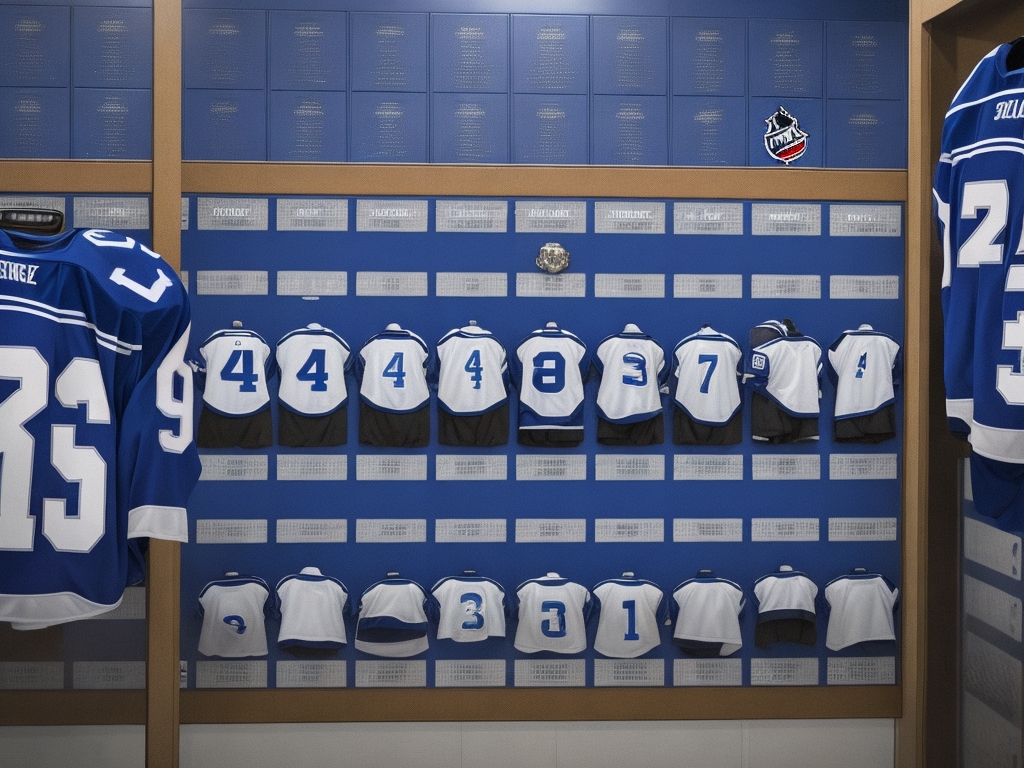
Table of Contents
ToggleHave you ever found yourself watching a thrilling hockey game and wondered, “Just how many players are on a hockey team?”
There’s more than just thrilling goals and whopping saves; understanding the number of players and their roles offer fascinating insights into this exhilarating game.
In today’s blog post, I talk about the formation of an NHL team roster – down to its last goaltender. Let’s put that puck in motion.

Throughout the history of the NHL, team roster sizes have undergone various changes and developments. Since the 1982-83 season, the current roster statute has been in effect, with teams consisting of 20 players – 18 skaters and 2 goaltenders.
However, before this standardized roster size was established, there were different variations.
In earlier years, teams had larger rosters with up to 25 players. This allowed for more flexibility in player substitutions and replacements during games. Over time, the league recognized that having too many players could lead to logistical challenges and limited playing opportunities for certain individuals.
As a result, they reduced the roster size to its current structure.
It’s important to note that even though only 20 players dress for each game now, teams still maintain an active roster of 23 players throughout the season. These additional three players serve as backups in case of illness or minor injuries to starting players.
Additionally, it’s worth mentioning that injured or sidelined players are typically seated in private sections or skyboxes during games. Even if these active players are recovering from injuries, they cannot participate in that particular game.
Understanding the history of NHL team roster sizes provides insights into how the league has evolved over time to ensure a balance between player participation and operational efficiency on game days.
The NHL roster size consists of a maximum of 20 players, including skaters and goaltenders.

In the highly competitive world of the NHL, it’s essential to know about roster sizes and player counts. The maximum number of players on a hockey team in this prestigious league is 23.
Out of those, 18 are skaters who keep the game lively with their rapid movements and amazing puck-handling abilities. The other two players are goaltenders, acting as the last line of defense against opposition attacks.
Hockey team roster size might seem large but considering the pace and physicality of NHL games, every single player plays a pivotal role – be it skating down the ice or making that crucial save for their side.
Each member contributes to their team’s success in their unique way which makes professional hockey teams not just a group, but an orchestra where everyone has got their part to play!
Read about: Free Agents in NHL
The team typically consists of 20 players, 18 of whom are skaters. These skaters are usually divided into 12 forwards and 6 defensemen. However, the coach can make changes as needed.
Now, let’s break it down further:
Type of Player | Number of Players |
Goaltenders | 2 |
Forwards | 12 |
Defensemen | 6 |
Total | 20 |
Apart from the 20 players, the team dresses 3 additional players. These extra players are available to step in case of illness or minor injury to the starting players. Before each game, the team must submit their game-day roster to the league, which always includes 2 goaltenders.
Although it’s rare, the team can sometimes call up a third goaltender to join the active roster. Typically, this is a short-lived arrangement. The sidelined players watch the game from the audience, often in a private section or skybox. Remember, even if an active player is injured, they are not eligible to play in that game.
In NHL games, getting your team ready means dressing 20 players for a match. This ensemble comprises specifically 18 skaters and 2 goaltenders. As part of the strategy, coaches usually divide the skaters into two groups -12 forwards and 6 defensemen which can be streamlined by the coach depending on game strategy or player availability.
Apart from this main lineup, teams have supplementary players at their disposal to step in when illness or minor injuries strike our starting stars. It’s worth noting that before any puck drops, each team is required to submit their gameday roster to gain league clearance for playtime.
So whether you’re rooting for a top-line center, an elite defenseman or a sturdy goalie on your favorite hockey squad, remember they are just part of a meticulously chosen group out of a potential pool of up to 23 active roster members including those who serve as substitutes during exigencies.
When we talk about goalies, we also should talk about GAA in Hockey. Read on to know more.

Teams in the NHL typically have a roster that consists of 18 skaters and 2 goaltenders, with a total of 20 players dressing for a game.
Maximum number of players allowed on the ice
In any given hockey team, including NHL teams, there are six players allowed on the ice at once.
This composition typically consists of three forwards, two defensemen, and one goaltender. The skaters work together to score goals and defend against their opponents, while the goaltender’s main job is to stop shots on net.
So next time you watch a game, keep an eye out for these six essential players making their moves on the ice!
Including goaltender and serving penalties
What about the composition of a hockey team and how do goaltenders and penalties fit into the equation? In an NHL game, a team consists of 20 players, with 18 skaters and 2 goaltenders.
The skaters are usually made up of 12 forwards and 6 defensemen, but the coach has some flexibility to modify this balance based on the game plan. When it comes to penalties, teams can substitute players who are serving their time in the penalty box.
This means that even though a player may be temporarily off the ice due to a penalty, there is still a full roster on hand to maintain competitive play. It’s important for teams to strategically manage their active roster submissions before each game so they have all positions covered and can adapt as needed throughout the match.
The NHL roster limit can vary throughout the season due to trade deadlines, injured reserve, and special provisions like the 90-player reserved list. In addition, the 2020-21 season introduced unique roster rules with the inclusion of the Taxi Squad.
As the trade deadline passes and the season continues, NHL teams face changes to their roster limits. During this period, teams can no longer freely make trades but must work with the players they have until the end of the season.
This means that any additions or subtractions to a team’s roster can only be made through call-ups from AHL-affiliate teams or waivers. Injured reserve also plays a role in determining how many players are on a hockey team during this time, as sidelined players may still count towards the maximum 50 player limit under standard contracts.
The trade deadline marks a crucial point in each season where teams must strategize with their current lineup until they reach the playoffs or conclude their campaign.
In a typical ice hockey game, when a player is injured and unable to play, they are placed on the injured reserve list.
This means that they are temporarily removed from the active roster, creating room for another player to join the team. The roster limit changes during this time, allowing teams to bring in more players to compensate for injuries.
It’s important to note that even though these injured players are still part of the active roster, they are not eligible to participate in games until they have fully recovered. This flexibility in managing rosters ensures that teams can continue competing at their best despite any temporary setbacks caused by injuries.
What about the depth of player options teams have at their disposal?
Enter the 90-player reserved list in the NHL.
This list allows teams to maintain up to 90 players who can potentially contribute to their roster throughout the season.
It serves as an insurance policy against injuries or illnesses that may sideline starting players. These additional players not only provide depth but also have the opportunity to showcase their skills by playing for AHL-affiliate teams.
With this extensive pool of talent, teams can ensure they have capable replacements ready when needed and maintain a competitive edge throughout the season.

In addition to the standard gameday roster count, there is an interesting exception known as the Emergency Backup Goaltender (EBUG).
If you’ve been following hockey for a while now seriously, you may have heard of the term “Emergency Backup Goaltender” or EBUG.
An EBUG is a unique position in hockey where an individual serves as a substitute goaltender for a team during an unforeseen circumstance.
This can happen when both of the team’s primary goaltenders are unable to play due to injury or illness.
In these situations, the EBUG is often someone who has experience playing at a high level and is available to step in if needed. They may be affiliated with the team in some way, such as working as a practice goalie or having previous connections to the organization.
The role of an EBUG can bring about exciting moments in hockey games, as it gives an opportunity for someone unexpected to take on the challenge of defending the net at a professional level.
It showcases not only their skills but also highlights the depth and unpredictability that makes hockey so thrilling.
So there we are; a hockey team in the NHL consists of 20 players, including 18 skaters and 2 goaltenders. The composition of the team can vary but typically includes 12 forwards and 6 defensemen.
This roster size has been in place since the 1982-83 season, allowing teams to have extra players available for substitutions or injuries. Ultimately, having a strong lineup is crucial for success on the ice.
Share:
OrangeandBlackPack.com is a participant in the Amazon Services LLC Associates Program, an affiliate advertising program designed to provide a means for sites to earn advertising fees by advertising and linking to awin, amazon.com and affiliated websites. Amazon, the Amazon logo, AmazonSupply, and the AmazonSupply logo are trademarks of Amazon.com, Inc. or its affiliates.
Address: 2430 N 20th St, Philadelphia, PA 19132, USA
© 2024 Orange and Black Pack